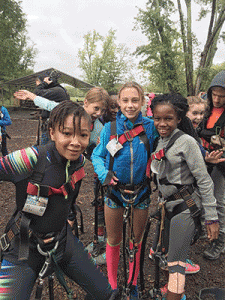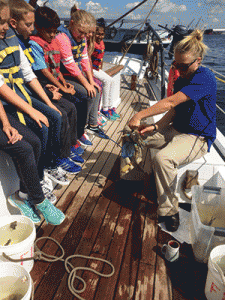
Looking back, my most memorable field trip was one with nearly no educational value. In sixth grade, our eccentric homeroom teacher loaded us onto the bus with our bathing suits, Super Soakers and bags upon bags of water balloons for a 45-minute drive to Catoctin Furnace. There, we engaged in a full-out boys versus girls water war, with all the requisite drama, accidental injury and poorly executed flirtation you’d expect.
I never thought, at 24, that I’d be making reference to the “good ol’ days.” But after talking to the staff at a number of local schools, I realize that my sixth-grade class’ romp wouldn’t even make it past the planning stages. In 2017, field trips are serious business.
“Philosophically, we love field trips to become an extension of our curriculum,” says Tung Trinh, head of the Middle School at Garrison Forest. “It’s a great way to make learning relevant and ensure there is a very clear connection between the kind of learning that takes place in the confines of our classroom and the real world. Forming these important connections allows students to be more critical, compassionate and curious about their own communities and really helps to make the learning stick.”
The middle school trips at GFS are in large part academic—during one, an architectural walk through Baltimore allows students to see the city’s similarities to ancient Greek and Roman architecture, later catalogued on Google Sketch-up—but the trips are also used as part of the students’ social educations. Sixth graders, for example, take a journey to Sandy Spring’s Adventure Park to complete a ropes course, which is seen as a sort of microcosm of the middle school experience: The students gravitate toward a certain group (in this case, based on course difficulty), overcome conflict to work together and see firsthand their peers’ strengths and weaknesses.

Ashleigh Wilkes, Lower School head at Harford Day School, concurs with the need for diversified trip experiences. Though the primary focus is to “enrich what our students are currently learning in class,” she says, “an added component…is building cooperation and teamwork skills that students will be able to apply to many situations throughout their academic and personal lives.”
And that’s not to mention the aspect most important to the students: having fun.
“While there is no question that our field trips support our pedagogical goals, it is equally apparent that they are fun!” says Gail Hutton, head of GFS’ Lower School. “Authentic student engagement and enjoyment and fostering their innate senses of wonder are the key components to ensuring the trip experience is memorable and enduring.”
So how do schools guarantee that their curricular enhancements are checking off the right boxes?
Wilkes says it’s as simple as following up. Though there is considerable logistical preparation involved, from venue research to parental communication and route planning, the easiest way to ensure a successful trip is to set clear expectations for the students…and make sure they’re met.
“Upon return from a trip or the next day, reflect on what was learned, discuss new ideas and share thoughts,” she says. “Really show the students how the trip connects to their curriculum and ask what they liked about it.”
For older students, however, a rise in the individualized field trip is challenging the traditional process.
“College counseling starts in ninth grade,” says Maryvale Prepatory School Director of Advancement Heather Harlan Warnack. “We offer field trips to colleges to expose the girls to different opportunities. It’s logistically very challenging, but the rewards are so great. It’s been very well-received.”
The school’s Leadership Institute, established in 2014, offers substantial field opportunities as well.
“Students travel to corporations such as UBS, Under Armour, Mercy and Hopkins, to name a few,” says Warnack. “It’s a fabulous opportunity to extend learning beyond the classroom, and give them real-world examples of career opportunities.”
Brian Schiffer, director of social sciences, fine arts and world languages for Baltimore County Public Schools, seconds the notion that the field trip experience is well worth the logistical challenges it can present. (He would know, too—he spends “a lot of time on the forms” for overnight and other extended class trips.)
“There’s a real push in our curricula to help students see the relevance of what they’re doing in the classroom,” he says. “The trips help teachers make those connections, and going on the trips also helps them pick up a new angle for a particular unit and get feedback from people in the field. It’s extremely valuable for everyone involved.” BC
Please visit the Maryland Teachers Guide for more field trip ideas.








